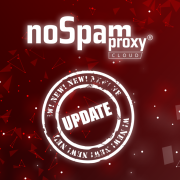The latest update extends the functionality of the Outlook Add-in to include encryption and signature functions, among other things. This means that shared stack customers can now also use features that were previously reserved for NoSpamProxy Server and Private Stack customers.
Please note that our support team will not be available on Thursday, May 30, 2024 due to the regional holiday (“Fronleichnam”). All incoming tickets will therefore not be processed until Friday, May 31, 2024.
From June 14, 2024, there will be a new certificate chain for email encryption for the Bundesagentur für Arbeit, the Jobcenters and the Institut für Arbeitsmarkt- und Berufsforschung. Find out what you need to do now in our blog article.
NoSpamProxy customers can now also use Sectigo certificates in the automated certificate management. This is particularly interesting for users of the German Research Network (DFN).
Both Barracuda and Sophos are approaching the end-of-life of their on-premises email security solutions. Our exclusive Competitive Upgrade PLUS sales promotion is aimed specifically at partners who support customers with Barracuda or Sophos email solutions. This is the perfect time to offer customers a future-proof alternative.
NoSpamProxy offers S/MIME- and PGP-based email encryption and thus lays the foundation for secure email communication, data protection and legal security. However, Microsoft also offers its customers the option of exchanging encrypted emails with Microsoft Purview Message Encryption. In this blog post, we explain whether a combination is possible and useful.
NoSpamProxy uses Bouncy Castle as an additional library for some operations. Bouncy Castle version 1.8.9 is used in the current NoSpamProxy version 15.1.940. Three new vulnerabilities have been published for Bouncy Castle. NoSpamProxy is not affected by any of these CVE.
On March 31, 2024, the transition phase of the changeover of the transmission path in the context of market communication ended. By this date, all participants in the electricity market had to have switched the transmission path from SMTP to AS4 in accordance with the BDEW guidelines. Since version 15, NoSpamProxy has also been offering this form of transmission and symbolically acts as a loading station between the SMTP and AS4 protocols. Read this blog article to find out which three points you should pay attention to when switching to the AS4 protocol.
NoSpamProxy
Categories
Latest News
 NoSpamProxy Cloud Update July 202424.07.2024 - 08:00
NoSpamProxy Cloud Update July 202424.07.2024 - 08:00 NoSpamProxy receives VBSpam+ Award (Q2/2024)23.07.2024 - 10:00
NoSpamProxy receives VBSpam+ Award (Q2/2024)23.07.2024 - 10:00 Looking back at the NoSpamProxy Roadshow 202401.07.2024 - 10:02
Looking back at the NoSpamProxy Roadshow 202401.07.2024 - 10:02





